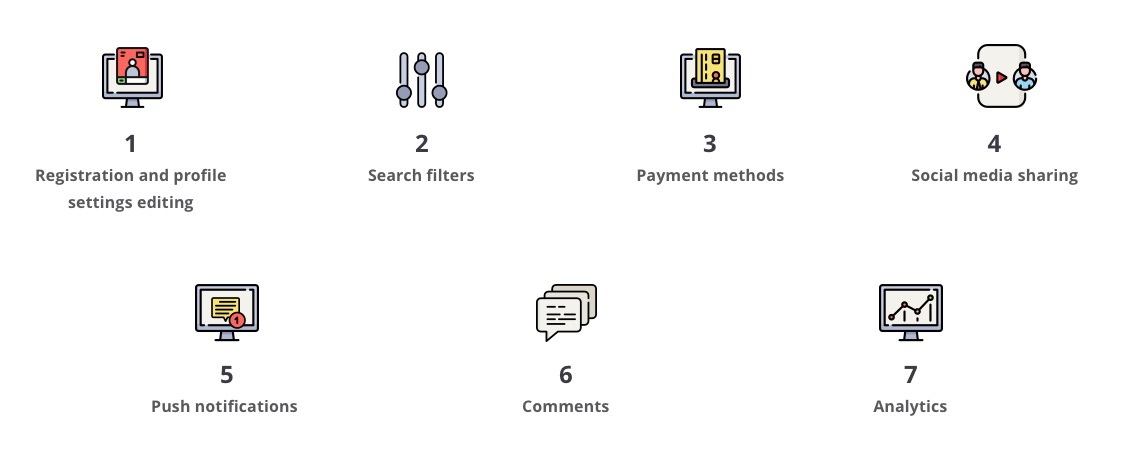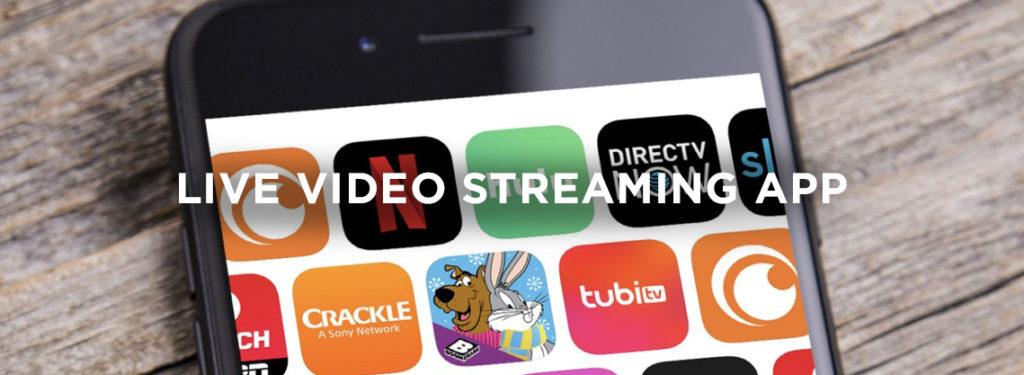Over the past years, the consumption of online media has increased substantially which resulted in the creation of new forms like video streaming. Due to this growth in popularity, video and music streaming retail services have become a highly competitive media and entertainment (M&E) industry segment. Yet, the use of streaming goes beyond M&E. Most probably, the reason for such a shift is that the content consumption habits have changed. People who are the actors in an increasingly digital ecosystem want to have round-the-clock access to the Internet and consume information while on the go. Live video streaming apps afford them this opportunity.
At the market, however, the relationship between supply and demand always tends to equilibrium. If users want to be online nearly all the time, the industry addresses this need immediately.
Online content available via live video streaming apps on each customer’s device with a fast enough Internet connection is an easy way for businesses to reach customers. Moreover, it is the global video streaming whose share is expected to amount to 60% of the global Internet traffic. Although live video streaming as a new source of entertainment and information in the digital environment has been introduced not so long ago, it without exaggeration means a lot for the industry. So, let’s take a closer look at this online video trend!
What is a live streaming app?
In itself, streaming is the process of moving different types of data to customers across communication channels without a drop in quality. Live video streaming services, on the whole, offer an alternative way of consuming TV/video content or even movie-going. Importantly, streaming video has started making traditional pay-TV services decline. The live streaming technology allows choosing precisely what to pay for and opting for on-demand TV instead of watching scheduled broadcast one. Who wants to pay for a bunch of channels they have no desire to watch?
Not only did the digital age form app consciousness but also it produced the whole App Generation that perceives the events of the past, present, and sometimes future through the “lens” of their smart devices. Researchers are constantly trying to recognize particular patterns. Before, we have investigated what differences they have discovered between Android and iOS users. The same goes for particular types of apps. The applications we use are believed to be the expression of our IT self-identities and exploited, in certain instances, for the purposes of socialization. The live streaming apps essence lies here, too.
The success of the applications sending a live video stream from anywhere in the world illustrates clearly how many things that belong to our everyday life and have not very much to do with the IT today can turn into an application tomorrow for its users to enjoy personalized services and for them to get an opportunity of expressing themselves.
Respectively, deciding on the best streaming apps for Android, iOS, or any desktop operating system is the key to understanding the phenomenon of live video streaming as such.
Amazing facts you didn’t know about live video streaming apps
42% of people don’t cancel their cable due to live TV.
Almost 80% of cable-keepers also use streaming apps.
People watch live videos 8 times longer than videos on demand.
In general, consumer tolerance for a bad stream is 90 seconds.
The majority of U.S. adults are currently paying $10 to $20 per month for streaming services.
On-demand video streaming has an emotional engagement rate of 17% compared to 25% in the case of live content streaming.
Twitch, one of the best live streaming apps for gaming, and 3.7 million monthly streamers in 2019.
Types of streaming apps
Though what streaming is seems clear, the way it is built into an app is narrowing the range of streaming application types allowing us to classify these apps into three groups. The main criterion is the remoteness of services from traditional TV. We may single out live TV, on-demand apps, and channels-services from independent networks from the totality of live video streaming apps.
1. Live TV.
This kind of streaming apps is perfect for those who cannot cut the cable cord that easily but are fed up with paying those huge TV bills. Full TV subscriptions are more expensive than streaming services. Video stream apps thus can lighten the burden. Live TV services allow watching TV shows that are on air at that particular moment.
e.g. YouTube TV, Hulu Live TV, DirecTV Now

In the age of interactive media, people expect to get content on demand. On-demand streaming apps allow accessing not the channels but specified shows. Users of this type of streaming services will not have to rely on the schedule. These are not real-time video streaming apps but prove to be even more convenient for people who are busy when their favorite show is broadcast. They pay a subscription fee to access services’ libraries at any time within the subscription period.
e.g. Netflix, Hulu, Amazon Prime Video
3. Channels-services from independent networks.
It means that paying for a subscription, one is not necessarily getting tied to the subscription taken out through a TV provider. These “channels as services” are part of the ecosystem of standalone streaming systems. They were created to complement the cable subscriptions. Presently, separate networks such as HBO and CBS can be added to streaming services for users to get select premium content. For instance, subscribers of CBS All Access can watch Star Trek: Discovery which is unavailable on CBS as a TV provider. Besides, it allows separating oneself from a cable commitment and consequently saving money.
e.g. HBO Now, CBS All Access, Showtime
Popular video stream apps
As a matter of fact, we all are witnessing the number of streaming services grow. Out of love of movies and TV shows multiplied by the benefits of a new form of content consumption, people are quickly becoming committed streaming service-subscribers. Even though we are singling out three types of applications, on-demand services are the most favored ones. These are believed to be the best live video streaming solutions in 2019:
1. Netflix.
Netflix is certainly the number one in the field. So, no wonder that people keep asking how to create a video streaming website like Netflix. According to recent statistics, 27.2% of Americans prefer this video streaming app to all other sources of TV content, which makes it the most popular platform in the USA. Launched as a DVD-by-mail service, it has disrupted the whole DVD rental industry and is targeting at the cable TV industry now. In addition to a huge library of movies and TV shows, Netflix invests much in the development of its own original programming which definitely makes it stand out.
2. Amazon Prime Video.
While Netflix has the greatest user base among all video-on-demand services (77%), nearly half of the VoD audience pay regularly for original content that goes with the Amazon Prime Video subscription. Evidently, 77 and 50 do not make 100%. This is the result of the American users’ inclination to pay for more than one streaming service at a time. Furthermore, why ignore so many perks Amazon offers? With this subscription, one can, among others, add premium “channels as services” we mentioned above to Amazon Prime Video application. Incidentally, it is much more economically advantageous to sign up for Amazon Prime membership ($119 per year) and get access to some other Amazon services than to spend $12.99 monthly for Video subscription only.
3. Hulu.
The service was initiated by Fox, NBCUniversal, and Disney to become one of the largest on-demand media libraries with a live TV streaming option. It has many different offerings for users whose price is formed depending on whether they want the service to be ad-free, wish to add Hulu Live TV, Enhanced DVR or the possibility of unlimited streams. Sure, Hulu possesses original programming that cannot be accessed anywhere else, too.
So, each on-demand streaming service subscription is beneficial in a way. Taking a closer look at them comparing the offerings will help to come to a decision so that the chosen option or options would fit nicely with who you are as a person and with your lifestyle.

Live video streaming features
Before answering the question of how to create a streaming website, let’s find out what features have to be developed. To make a video-streaming process enjoyable, live video streaming services should contain specific features. The top one is support for a mobile compatible player. It is important to ensure consistent user experience on various devices for the target market has become highly diverse. Live video streaming application for Android and iOS must be as user-friendly as websites for streaming. Thus, there are such Netflix-compatible devices as Smart TV, handheld devices, video game consoles, set-top boxes, handheld game consoles, Blu-ray players, digital video recorders, digital media receivers.
Further basic features of video streaming apps include:
- Registration and profile settings editing
- Search filters
- Payment methods
- Social media sharing
- Push notifications
- Comments
- Analytics

1. Big Data. An application for real-time data streaming is a buffer between publishers and users. So, for users to have an amazing experience, a lag time must be reduced. Needless to say, it is a big technical challenge. Thus, for the sake of proximity, original data is copied across hundreds of servers around the globe. But the latency elimination is only half of it: typically, a rich ecosystem of technologies has to facilitate algorithms and data analytics to customize the service.
Such processing frameworks as Storm, Samza, Flink, or Spark need to integrate with a streaming platform to process batch data and feed the data-processing pipeline.
2. The data-processing pipeline. Since data streams need fault-tolerant storage, processing, and geographical distribution, the above processing frameworks should rely on such queuing systems as Apache Kafka. This system must be considered when coding a streaming website. It is used for building real-time streaming applications and data pipelines. For example, Netflix utilizes Kafka as a real-time monitoring and event-processing pipeline and takes advantage of the microservice architecture based on micro-batch processing.
3. Caching and databases. To offset some frequently performed operations, caching is used. Amazon S3, AWS SimpleDB, Cassandra, and MySQL storage services that will ensure security, scalability, and data availability shortening access time.
4. Programming languages: Java, Python, JavaScript.
Live streaming monetization
The right tech stack in video streaming app development is no doubt paramount. Yet, the way the product is functioning and behaving matters much as well while its monetization is part of its performance. Normally, there are two ways to make money from an application: either to establish a price for it or to take advantage of free app monetization strategies. The video streaming industry is, however, a self-reproducing system. As a rule, such platforms not only offer huge libraries of movies but also they allow users to access original shows that are sometimes unavailable anywhere else but on the platforms-producers.
Production of new shows needs funding while the appetites of video streaming services are growing — in 2017, Netflix introduced 487 shows and the number in 2018 rose beyond 700. No wonder that companies are seeking extra ways to increase revenue. That is why there cannot possibly be any free streaming apps with high-quality content offered. Usually, users have to pay a subscription fee (though they also have an option to start a free trial first.)
Users of streaming platforms are, in fact, subscribers who periodically pay subscription fees and expect to get quality content on the platform that is not running ads. Thus, recent attempts of Netflix to test ads are reported to have been disapproved by its subscribers. Supposedly, if the service were not ad-free from the very beginning (as Hulu that offers a more expensive ad-free subscription plan), users were not that hard to get used to this new model. Therefore, the initial value proposition (ad presence inclusively) should be clearly identified so that the original programming was not wasted and no big experiments were required.
How much does it cost to build a video streaming platform?
The cost of developing a video streaming platform will vary either way. The development of live video streaming apps and the process of content-creation for them may be costly. At the same time, spendings and investments must not exceed the revenue. It is feasible to build a live streaming website & app moderating both fixed and optional expenses if you know some basic rules:
Research into market trends. It helps to decide on where your place at this market is going to be.
Do not disregard prototypes and specifications. They are important in laying out options for each stage of the development process wisely.
Provide the quality UX/UI design for application or website usability.
Make sure the product has all the features the video streaming platform needs.
Support and maintain.
The cost, as well as the duration of each stage, depends on the level of complexity which is defined when talking it over with the contractor.
Conclusion
Evidently, video streaming apps are becoming a large part of popular culture. Moreover, there is a variety of app types to choose from. With a view to creating a live video streaming application that would become another substitution for the traditional TV, one is yet free to decide on what they want to offer future users and also dependent on the trends and conditions the industry with such giants as Netflix and Hulu is already setting.
Nevertheless, a team of passionate experts who are familiar with the technologies used in the streaming platform development and have a thing with the motion picture industry will drive you to success!

© 2019, Vilmate LLC




